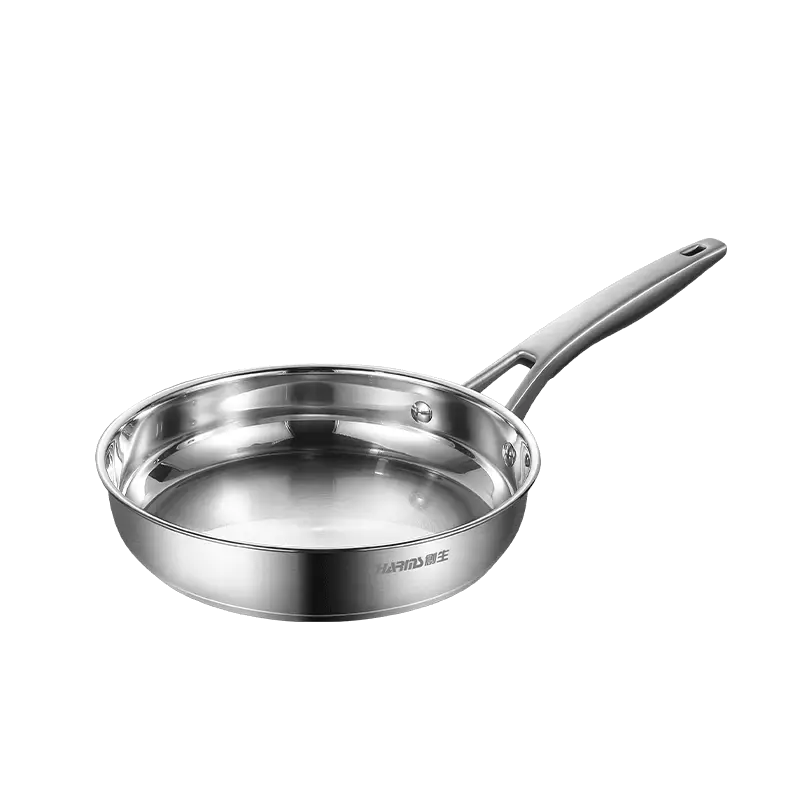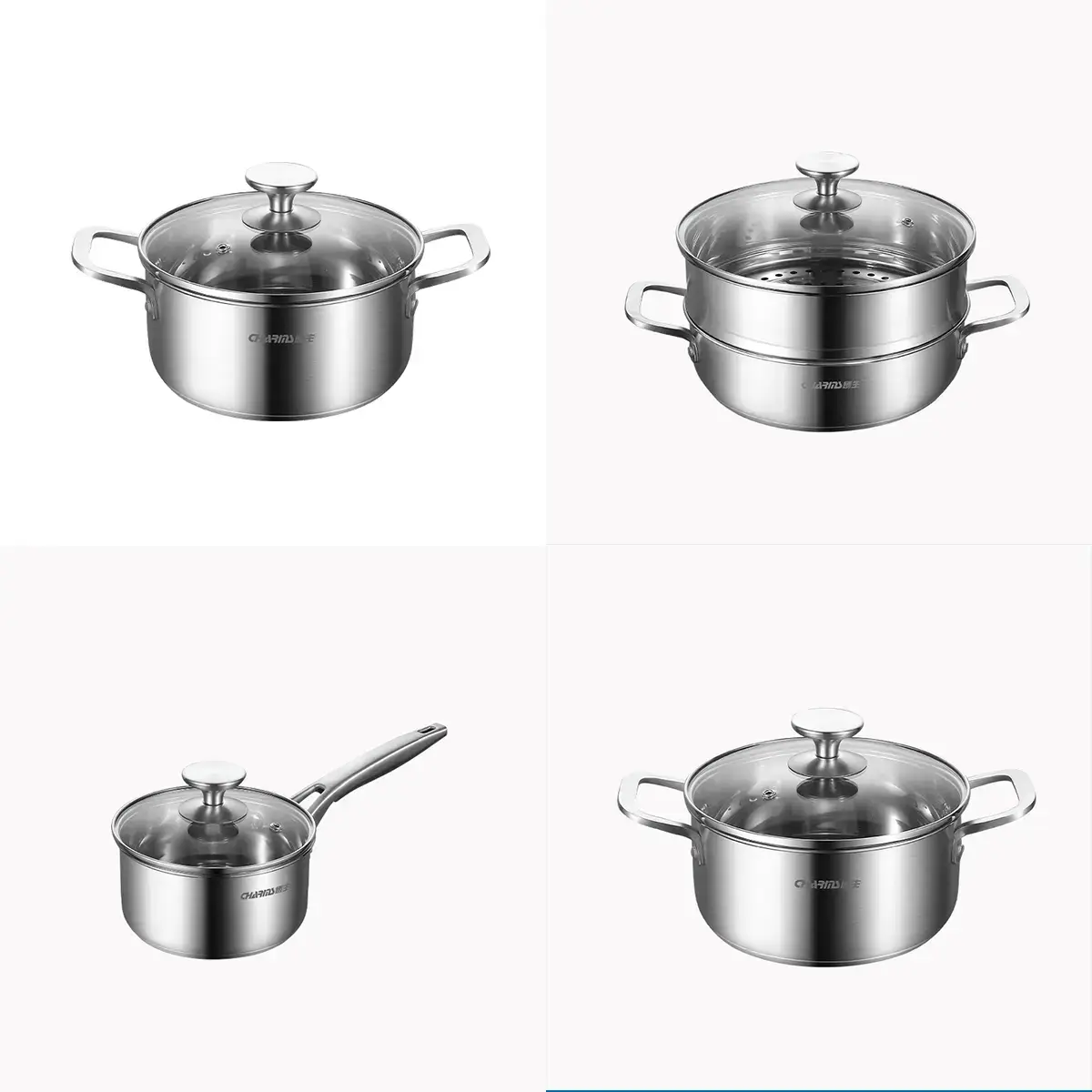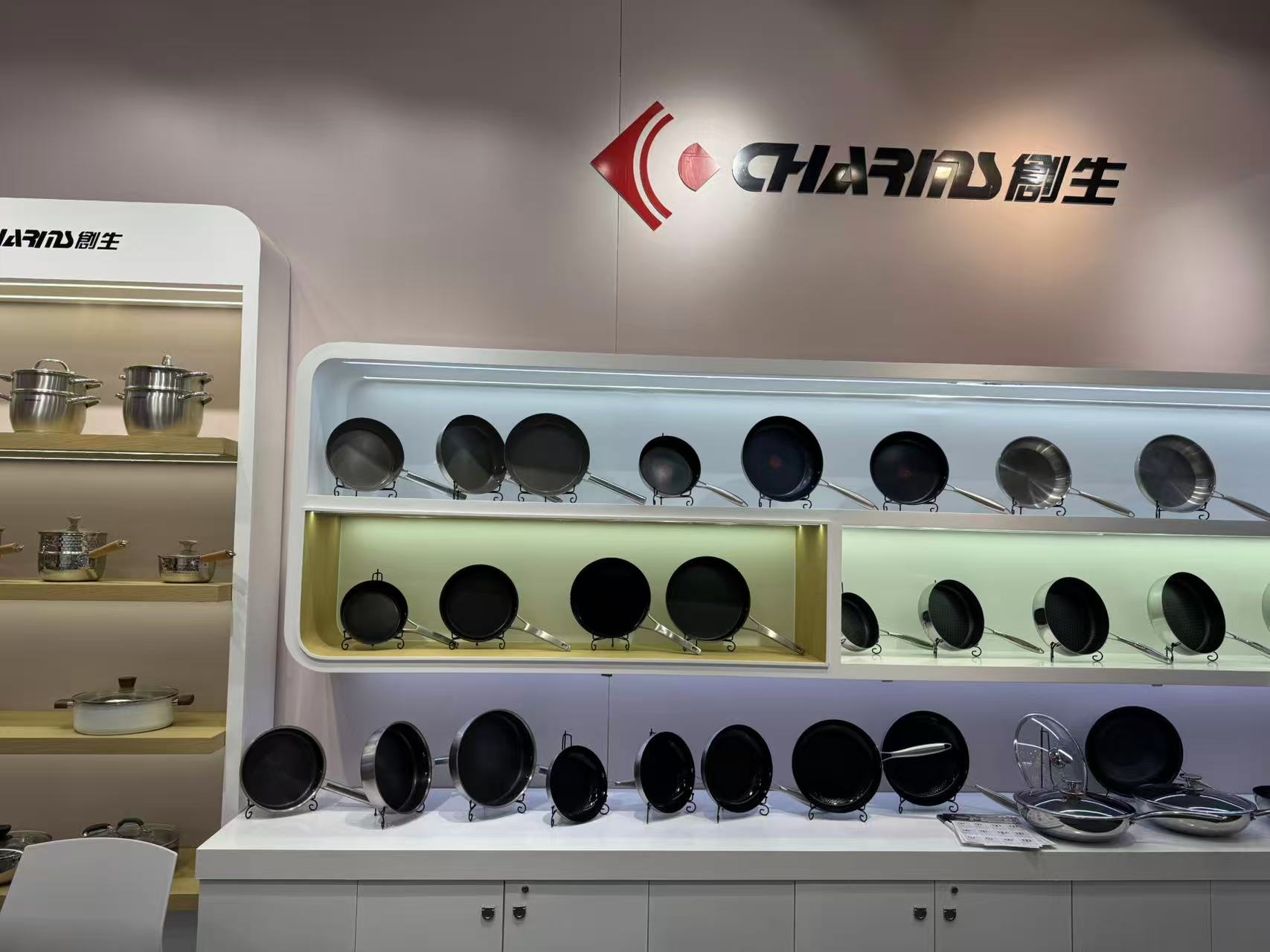Picking nonstick vs. stainless steel pans in a pro kitchen isn’t just about personal preference—it’s a call based on performance, durability, safety, and how precise you need to be with cooking. Every pan has a job, and whether you’re in a fancy restaurant or a busy diner, chefs know how to balance control, speed, and make sure every dish turns out the same great way.
The cookware you choose doesn’t just affect how your food cooks—it changes the taste, how fast your kitchen runs, and how long your gear lasts. If you wanna pick the right tools, you gotta start by understanding what chefs look for in these materials.
What’s Really the Difference Between Nonstick and Stainless Steel?
The gap starts with the surface, but it goes way deeper—into how they handle heat, how long they last, even the kinds of food you can make with ’em.
Stainless steel cookware is built for toughness and precision. It’s usually got a layered build: stainless steel on the inside and outside, with an aluminum or copper core glued in between. That layering makes heat spread fast and evenly, while keeping the cooking surface from reacting with food. This stuff lasts forever—even through years of slamming it around a busy pro kitchen.
Nonstick pans, though? They rely on a coating to cut down on friction. The most common ones use PTFE (that’s Teflon, basically) or newer ceramic-like coatings. That smooth surface keeps food from sticking, so you can cook with less oil and clean up way faster. But coatings have limits: heat ’em too much, and they break down. Scrape ’em with metal utensils, and you’ll ruin ’em. And in a commercial kitchen? They usually don’t last nearly as long.
The biggest difference in cooking? How food reacts with heat. Stainless steel helps with browning and caramelization—those are the processes that make food taste rich and deep. Nonstick stops that reaction, so food stays lighter in color and softer in texture, but it slides out super easily and looks consistent every time. Both have their wins: stainless steel builds flavor and texture, and nonstick makes for easy releases and speed.

Why Do Pro Chefs Usually Pick Stainless Steel?
Most pro chefs lean toward stainless steel because it’s all about control, consistency, and durability—three things you need in a high-pressure kitchen.
- Stainless steel lets you cook at high temperatures without wrecking the pan. It’s perfect for searing, deglazing, and reducing sauces. Being able to build up fond (those browned bits on the bottom) is make-or-break for rich sauces and flavor bases. Nonstick coatings kill that process, so you lose out on depth.
- It stays stable with heat, so every dish turns out the same. When a chef drops cold meat into a hot stainless steel pan, the thick bottom holds onto heat and keeps the temperature even across the whole surface. That control is key for getting a perfect sear and knowing exactly how long food will take to cook.
- It can handle the abuse of a commercial kitchen. Scrub it hard, run it through the dishwasher, douse it with sanitizing chemicals—none of that messes it up. Nonstick needs gentle care, and it wears out faster. If you’re using it across multiple stations, you’ll end up replacing it way more (and spending more money).
- It’s versatile as hell. You can take the same pan from the stovetop to the oven, hold it over an open flame, even stick it under a grill. For kitchens that need to be flexible, stainless steel is the do-it-all tool.
Do Chefs Ever Use Nonstick Pans?
Heck yeah—nonstick has a clear, important job in pro kitchens. When you need food to slide out perfectly or handle delicate stuff, it’s the go-to.
Nonstick is perfect for eggs, crepes, pancakes, and fragile fish fillets. Those foods pop right out, and it heats ’em evenly at moderate temps. The coating also lets you use way less oil, which is great for lighter cooking and keeping portion sizes consistent.
If you’re cranking out breakfast for a crowd or prepping a fancy dinner, nonstick can speed things up and cut down on wasted food.
But pros don’t just grab nonstick willy-nilly—they set rules. No high-heat searing, never preheat an empty nonstick pan, and they keep coated pans in specific stations so they don’t get exposed to extreme heat or metal utensils. Nonstick is a tool, not a replacement for everything. It works for precise cooking and quick, repeat tasks—but it’s not the workhorse of the kitchen.

How Does Cooking Technique Change Which Pan You Use?
The way you cook decides what you need from a pan. Chefs pick materials based on how heat, oil, and food interact for each method.
Searing and Browning
Searing needs a hot surface that holds heat well. Stainless steel shines here—it gets hot enough to trigger the Maillard reaction (that’s what makes seared meat taste so good) and builds that crispy outer layer. Nonstick can’t handle those temps without breaking down, so it’s out for searing.
Deglazing and Making Sauces
A lot of classic sauces start with pouring liquid into the pan to lift up those browned fond bits. Stainless steel has no coating, so that fond sticks (in a good way)—you can dissolve it and turn it into a rich sauce. Nonstick stops fond from forming, so you miss out on that layered flavor.
Low-Heat Cooking and Delicate Foods
Nonstick is great for keeping the heat gentle. Even with a little oil, food barely sticks. When you need to control the temp perfectly and get food out without breaking it, nonstick makes the job fast and steady.
Oven Cooking and Grilling
Lots of pro recipes need you to move a pan from the stovetop to the oven. Stainless steel is safe at high oven temps, and it can handle being under a grill too. Most nonstick coatings have a temp limit—they’re not for grills or long oven stays.
Cleaning and Turnaround Time
In kitchens where you need to clean fast between uses, stainless steel wins. It can take rough scrubbing. Nonstick needs soft sponges and mild soap—if you don’t have a clear system for that, it slows down your kitchen’s pace.
At the end of the day, your technique picks the material. The right pan makes sure your cooking method works its best—without sacrificing safety or speed.

Is Stainless Steel Really Harder to Use or Clean?
A lot of people think stainless steel is tricky—but it’s just about knowing the trick, not working harder. Once you get it, it gives you precision you can’t get with coated pans.
Food sticks to stainless steel usually because you messed up the heat. The fix is simple: Preheat the pan, wait till the oil shimmers (that’s your cue it’s hot), then add the food. Once the protein cooks through, it’ll release on its own. Patience and timing are key—this method gives you even results every time, and way less sticking.
For cleaning? Stainless steel is tough as nails. Scrub it with a metal pad, run it through a hot dishwasher, soak it in degreaser—none of that damages it. If it gets discolored or has leftover gunk, just use a stainless steel polish to get it shiny and working like new.
Nonstick might wipe clean easier after gentle use, but you gotta baby it: No abrasives, no metal tools, no overheating. Even with good cleaning, the coating wears out over time. So yeah, stainless steel might seem like it needs more know-how, but in a busy kitchen? It’s usually cheaper and more reliable in the long run.
The secret is training. Once your kitchen team learns how to preheat right, manage oil, and clean it properly, stainless steel stops feeling hard—it starts feeling easy.
Health and Safety: Which Is Better?
Safety is a big deal when picking pro cookware. Both are safe if you use ’em right, but they have different risks and care needs.
Stainless Steel Safety
Stainless steel is inert (that means it doesn’t react) in most cooking situations. It won’t leach weird stuff into food, even at high heat. It can handle acidic ingredients, repeated heating and cooling, and strong cleaners. No coating means no risk of it breaking down or flaking off into food. For hygiene? You can sanitize it in a hot dishwasher or sink without ruining it.
Nonstick Safety
Modern nonstick coatings—especially PTFE ones—are safe if you stick to the manufacturer’s temp limits. Problems pop up when nonstick pans heat up past around 260-300°C (500-572°F). At those temps, the coating can break down, release fumes, or lose its structure.
Nonstick is safe in controlled settings, but commercial use needs strict training to keep it from getting too hot.
Ceramic-coated nonstick pans don’t have PTFE, but they wear out faster. No matter what coating you use, you gotta replace the pan once the coating starts to fail—otherwise, you lose performance (and safety).

Hygiene and Cross-Contamination
Stainless steel doesn’t rust, so it’s easy to keep super clean. Nonstick needs careful scrubbing to avoid scratching the coating—and scratches make it harder to keep sanitary in a pro kitchen. That’s why a lot of places only use nonstick for specific, low-risk jobs and rely on stainless steel for most big-batch cooking.
At the end of the day, health and safety aren’t about the material—it’s about using it right, controlling the heat, and taking care of it. Stainless steel gives you more room to mess up safely, while nonstick is convenient as long as you follow the rules.
How Do Chefs Choose Between Nonstick and Stainless Steel?
Picking pro cookware follows a simple logic. Chefs and kitchen managers look at how their kitchen runs, then decide what material fits.
- What are you cooking? Every pan should have a job. Stainless steel is best for searing, baking, and making sauces. Nonstick is better for delicate, low-oil cooking. Picking the wrong pan messes up food quality and shortens the pan’s life.
- What kind of heat and equipment do you have? Commercial kitchens are different—gas stoves, electric, induction—they all work differently. Stainless steel with an aluminum or copper core spreads heat evenly and works on induction. Nonstick might need a magnetic bottom to work on induction.
- How skilled is your team? If you’ve got chefs who know how to control heat, stainless steel will make their dishes shine. If you rely on less experienced staff, nonstick can cut down on mistakes and wasted food.
- How long will it last, and how much will it cost long-term? In pro kitchens, the total cost matters more than the upfront price. Good stainless steel pans can last 10 years or more. Nonstick wears out fast, so you replace it often. When you calculate cost per use, stainless steel usually wins.
- How fast do you need to clean and reuse pans? In a busy kitchen where you’re cleaning nonstop, stainless steel is better. Nonstick needs gentle care—you can’t scrub it hard or use hot cleaners. Having a cleaning plan for each pan type keeps ’em durable and clean.
- What’s on your menu? If you focus on seared meats, rich sauces, or reduced stocks, stainless steel is a must. If your menu is all about healthy, low-fat dishes, nonstick helps with less oil. Your pan collection should match what your restaurant is known for.
- Is it comfortable to use, and does it fit your workflow? Weight, handle design, balance—all that affects how fast your kitchen moves. Stainless steel is heavier but sturdier; nonstick is lighter, so it’s easier for repeated tasks. Picking pans that feel good to use cuts down on tired hands and speeds things up.
- Is it good for the environment? Stainless steel is fully recyclable and lasts forever, so it cuts down on waste. Nonstick uses synthetic coatings and needs special recycling. If you care about being eco-friendly, stainless steel fits long-term sustainability goals.
Basically, chefs don’t ask “which pan is better”—they ask “which pan works best for this job in my kitchen.” The answer is almost always a mix: stainless steel for durability and high heat, nonstick for delicate, fast cooking.
Conclusion
Chefs use both nonstick and stainless steel—but they’re not interchangeable. Stainless steel is the backbone of a pro kitchen: it takes high heat, builds flavor, and lasts through years of abuse. Nonstick is more fragile, but it’s perfect for specific jobs—like getting food to slide out clean or cooking with less oil.
The real difference comes down to intention. Stainless steel is for creativity, heat control, and long-term value. Nonstick is for consistency, speed, and ease. If you’re buying pro cookware, the most efficient kitchen setup uses both: stainless steel as your workhorse, nonstick as your specialty tool.





